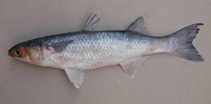http://www.fishbase.org/Summary/speciesSummary.php?genusname=Mugil&speciesname=incilis ---> http://192.134.151.83/Summary/speciesSummary.php?genusname=Mugil&speciesname=incilis
http://192.134.151.83/Summary/speciesSummary.php?genusname=Mugil&speciesname=incilis ---> https://fishbase.mnhn.fr/Summary/speciesSummary.php?genusname=Mugil&speciesname=incilis
https://fishbase.mnhn.fr/Summary/speciesSummary.php?genusname=Mugil&speciesname=incilis ---> https://fishbase.mnhn.fr/summary/Mugil-incilis.html
Mugil incilis, Parassi mullet : fisheries

You can
sponsor
this page
Common name (e.g. trout)
Genus + Species (e.g. Gadus morhua)
-

-
About this page
-
Languages
-
User feedbacks
-
Citation
-
Uploads
-
Related species
-


 Parassi mullet
Add your observation in
Fish Watcher
Upload your
photos
and
videos
Parassi mullet
Add your observation in
Fish Watcher
Upload your
photos
and
videos
Pictures
|
Google image
 Mugil incilis
Mugil incilis
Picture by
Carvalho Filho, A.
Teleostei (teleosts) >
Mugiliformes
(Mullets) >
Mugilidae
(Mullets)
Etymology:
Mugil:
Latin, mugil, -ilis = grey mullet (Ref.
45335
)
.
Environment: milieu / climate zone / depth range / distribution range
Ecology
Marine; brackish; demersal; depth range 10 - ? m (Ref.
5217
). Tropical; 13°N - 9°S
Western Atlantic: West Indies and the Atlantic coasts of Central and South America to southeastern Brazil.
Length at first maturity / Size / Weight / Age
Maturity: L
m
?
, range 24 - ? cm
Max length : 40.0 cm TL male/unsexed; (Ref.
3791
); 35.0 cm TL (female); common length : 25.0 cm TL male/unsexed; (Ref.
5217
)
Mainly found in brackish estuaries but also in marine and hyper-saline waters (Ref.
5217
). During reproduction, they gather in small groups at the mouth of coastal rivers and creeks. Reproduction occurs in the early part of the year. Oviparous, eggs are pelagic and non-adhesive (Ref.
205
). Eggs which are rich in yolk are spawned by the millions. Upon hatching, juveniles move up to the swamps and coastal rivers over long distances, to seek for food and to protect themselves against predators (Ref.
35237
). Marketed fresh or salted (Ref.
5217
). The roe is marketed salt-pickled and dried and considered a delicacy (Ref.
5217
).
Life cycle and mating behavior
Maturity
|
Reproduction
|
Spawning
|
Eggs
|
Fecundity
|
Larvae
Spawning seems to take place in small groups in river mouths. Females lay millions of relatively large eggs rich in yolk.
Thomson, J.M.
, 1978. Mugilidae. In W. Fischer (ed.) FAO species identification sheets for fishery purposes. Western Central Atlantic (Fishing Area 31). Vol. 3. [pag. var.]. FAO, Rome. (Ref.
3791
)
IUCN Red List Status (Ref.
130435
)
Least Concern (LC)
; Date assessed:
04 February 2009
CITES
Not Evaluated
Not Evaluated
Threat to humans
Harmless
Human uses
Fisheries: minor commercial
FAO - Fisheries:
landings
; Publication:
search
|
FishSource
|
Sea Around Us
More information
Countries
FAO areas
Ecosystems
Occurrences
Introductions
Stocks
Ecology
Diet
Food items
Food consumption
Ration
Common names
Synonyms
Metabolism
Predators
Ecotoxicology
Reproduction
Maturity
Spawning
Spawning aggregation
Fecundity
Eggs
Egg development
Age/Size
Growth
Length-weight
Length-length
Length-frequencies
Morphometrics
Morphology
Larvae
Larval dynamics
Recruitment
Abundance
BRUVS
References
Aquaculture
Aquaculture profile
Strains
Genetics
Electrophoreses
Heritability
Diseases
Processing
Nutrients
Mass conversion
Collaborators
Pictures
Stamps, Coins Misc.
Sounds
Ciguatera
Speed
Swim. type
Gill area
Otoliths
Brains
Vision
Tools
E-book
|
Field guide
|
Identification keys
|
Length-frequency wizard
|
Life-history tool
|
Point map
|
Classification Tree
|
Catch-MSY
|
Special reports
Check for Aquarium maintenance
|
Check for Species Fact Sheets
|
Check for Aquaculture Fact Sheets
Download XML
Summary page
|
Point data
|
Common names
|
Photos
Internet sources
AFORO (otoliths) |
Aquatic Commons
|
BHL
|
Cloffa
|
BOLDSystems
|
Websites from users
|
Check FishWatcher
|
CISTI
|
Catalog of Fishes
:
genus
,
species
|
DiscoverLife
|
ECOTOX
| FAO - Fisheries:
landings
; Publication:
search
|
Faunafri
| Fishipedia |
Fishtrace
| GenBank:
genome
,
nucleotide
|
GloBI
|
Google Books
|
Google Scholar
|
Google
| IGFA World Record |
MitoFish
|
Otolith Atlas of Taiwan Fishes
|
PubMed
| Reef Life Survey | Socotra Atlas |
Tree of Life
| Wikipedia:
Go
,
Search
| World Records Freshwater Fishing |
Zoobank
|
Zoological Record
Estimates based on models
Preferred temperature (Ref.
123201
): 26.7 - 28.1, mean 27.4 °C (based on 46 cells).
Phylogenetic diversity index (Ref.
82804
): PD
50
= 0.5000 [Uniqueness, from 0.5 = low to 2.0 = high].
Bayesian length-weight: a=0.00977 (0.00595 - 0.01605), b=2.91 (2.78 - 3.04), in cm total length, based on LWR estimates for this species & Genus-body shape (Ref.
93245
).
Trophic level (Ref.
69278
): 2.0 ±0.1 se; based on diet studies.
Generation time: 1.6 ( na - na) years. Estimated as median ln(3)/K based on 1
growth studies.
Resilience (Ref.
120179
): High, minimum population doubling time less than 15 months (Preliminary K or Fecundity.).
Fishing Vulnerability (Ref.
59153
): Low vulnerability (24 of 100).
Price category (Ref.
80766
):
Medium
.
Nutrients (Ref.
124155
): Calcium = 482 [175, 1,568] mg/100g; Iron = 3.8 [0.7, 17.5] mg/100g; Protein = 19.2 [17.6, 20.7] %; Omega3 = 0.359 [0.158, 0.859] g/100g; Selenium = 150 [48, 491] μg/100g; VitaminA = 7.99 [2.21, 28.34] μg/100g; Zinc = 3.19 [1.47, 7.74] mg/100g (wet weight);
Back to Search
Random Species
Back to Top
Accessed through:
Not available
FishBase mirror site :
localhost
Page last modified by :
mrius-barile
- 20 July 2016
Fatal error
: Uncaught ArgumentCountError: Too few arguments to function checkEcotox(), 1 passed in /var/www/html/summary/speciessummary.php on line 2304 and exactly 3 expected in /var/www/html/includes/speciessummary.lib.php:2579 Stack trace: #0 /var/www/html/summary/speciessummary.php(2304): checkEcotox() #1 {main} thrown in
/var/www/html/includes/speciessummary.lib.php
on line
2579
|